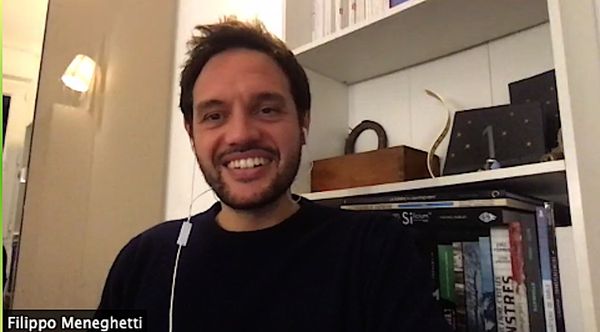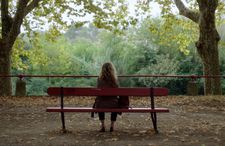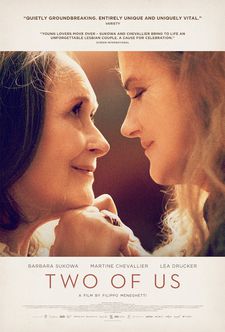 |
| Filippo Meneghetti on Barbara Sukowa, Martine Chevallier, and Léa Drucker: “It is such a gift that they are trusting me on my first feature with their talent and experience …” |
Filippo Meneghetti’s enigmatic Two Of Us (Deux), co-written with Malysone Bovorasmy and Florence Vignon, stars Barbara Sukowa and Martine Chevallier (co-winners of the 2021 Best Actress Lumière Award) with Léa Drucker, Jérôme Varanfrain, and Augustin Reynes. In Meneghetti’s debut feature (France’s Oscar submission, a New Directors/New Films highlight and the Lumière Award-winner for Best First Film) there are horror and thriller elements accompanying the challenging performances.
Two little girls playing hide-and-seek by the river fashion the unexplained mystery thread throughout this film about open and closed doors. Nina (Sukowa) and Madeleine (Chevallier) go about their routines. They have two adjacent apartments and plan to move to Rome together. At night, our perspective resembles that of a spy who is watching them from the other side of their shared bed.
 |
| Madeleine (Martine Chevallier) with Nina (Barbara Sukowa) in Two Of Us (Deux) |
For Madeleine’s children Anne (Drucker) and Frédéric (Varanfrain), Nina is just a neighbour and not the love of their mother’s life. Grandson Théo (Reynes) has the best rapport with grandma and openness in his eyes. When things get complicated and age-old secrecy takes its toll, Filippo Meneghetti opens up his narratives into other genres.
Exactly two days to the minute from the inauguration ceremony for President Joe Biden and Vice President Kamala Harris in front of the United States Capitol, Filippo Meneghetti and Barbara Sukowa joined me for a Zoom conversation.
Anne-Katrin Titze: My location is very close to Barbara’s in Brooklyn. Filippo, where are you?
Filippo Meneghetti: I’m very close to Marseille. So, very far from you.
AKT: First of all, congratulations on the Lumière Award. Tell me about the beginning of the project.
FM: When Barbara and Martine got involved - we started to get to meet and know the person. You know the talent of the actress but then you get to see the energy that they have, the way they behave. So we changed slight things in the character - what she would or she wouldn’t do - according to Barbara or Martine and also Léa Drucker. It is such a gift that they are trusting me on my first feature with their talent and experience, that I have to try and make the most out of it.
AKT: You do include a lot of different genres!
 |
| Anne (Léa Drucker) with her mother Madeleine (Martine Chevallier) |
FM: The film could have been a melodrama, it was leaning towards that kind of story, but I really didn’t want to do that. I really since the beginning wanted to use the thriller element because love is a very complex feeling and a thriller is a very good tool if you want to tell about obsession and anxiety and lack of somebody else. Also there is something in the thriller structure that is interesting.
They have a long love story behind them, so there is a lot of information in the backstory. I really didn’t want to use flashback because I wanted to have a kind of compact object film. The idea of a thriller is also a lot about information and giving information and hiding information and using those to create an emotion.
AKT: Right!
FM: So that was a good tool. And using the different genres, I like the freedom of tone that you can have in cinema. And it’s also a way to play with the audience, because the audience knows that kind of thing. You can play with their expectation and by that play with the audience. Also, it was funny, because sometimes I was thinking, we are doing that kind of film but on our little small scale. It’s going to be a Western confrontation but in a small apartment. Or a war scene in a small apartment.
AKT: You say Western and war in a small apartment? That’s good.
 |
| Filippo Meneghetti on the red bench: “The idea is to create a place where the audience can room with the characters and can share the space …” |
FM: Yeah, Barbara, sometimes she’s like a thief.
AKT: And so are we the audience! In the beginning when we first see the two of them, we are like burglars hiding behind the bed. Your camera angles [cinematography by Aurélien Marra] give us that detective perspective as well. You mentioned hiding just now. Your film starts with two little girls. This is really the mystery of the entire film. Twice the girl in the white dress returns. Do you want to talk about the girls or keep it as a mystery?
FM: No, of course I can talk about it. There are different ideas behind that part of the film. First of all was to create a space, mind-space that they both share, Nina and Madeleine. You know, when two lovers are really close to each other you don’t have to speak, you have the same things in mind, you’re in the same place. That was somehow our way to convey that feeling, that they can be in that space, which is also the same space in which they have that red bench where they go and which comes again, also in the real life part of the film.
I like to engage the audience and I see my job also as a way to create room for the audience to experience, to gather their own emotion in their own way. So I don’t want to push too much things and meanings towards the audience. The idea was to create the space which stays ambiguous by choice. It can be so many things. It is not a flashback but it can be a premonition. It can be a metaphor of things hiding under a surface. Also, the girl, she cannot speak.
 |
| Filippo Meneghetti: “Madeleine’s (Martine Chevallier) apartment is so cozy and full of all the objects of her life of the family.” |
The idea is to create a place where the audience can room with the characters and can share the space with the characters, Nina and Madeleine. And hopefully if two hours after the end of the screening they find themselves thinking about it, then I’m very glad.
AKT: Perfect explanation. What you do with the apartments is in a way similar. We don’t see Nina’s apartment for such a long time and when we see it, the emptiness gives us room for lots of different interpretations. One interpretation is that she lives elsewhere, another that this is in preparation for Rome, which is ultimately disappointed.
FM: The two apartments are really at the core of the film since the beginning, even before the script. The idea started basically with these two apartments and the landing that becomes a border and the two doors that are always open and then always shut. That’s a metaphor of what is happening inside the characters. What was interesting for me in the two apartments is that they are kind of mirrors of the characters.
Madeleine’s apartment is so cosy and full of all the objects of her life of the family. It is so cosy that it has a weight on her. It’s so cosy that you don’t want to live in it. While Nina’s apartment, which is empty, mirrors her state of mind after the stroke. She feels empty, she feels lacking of Madeleine. A precise strategy about the point of view - we wanted to start the film with Madeleine and we wanted, since the writing, to never let the camera into Nina’s apartment before the stroke, because we want the audience to find out later that that apartment is actually a fake apartment, she never goes into it or just to store things.
 |
| Two Of Us poster |
AKT: Which makes it a double nightmare for her. Everything is gone at that moment.
FM: Exactly. And for the audience as well. They realize the emptiness when they find out.
AKT: You keep us on our toes with Bart, the cat. You keep your audience worried about him till the very end. Was Bart, the cat always part of this?
FM: Yeah, he was always in the script since the very first draft. On one level, it’s kind of a private joke for myself and real people that I know. On another level, I like to shoot animals [on film] and I really enjoy that. It was interesting for me to put in this free element, something that in this chamber piece, something that would not be possible to handle perfectly. A strange weakness to the story, which doesn’t care about anything because it’s just there. I like this kind of irony of the cat that is just living its life while very dramatic things are going on.
Coming up - Filippo Meneghetti on betrayal, complex love, the intensity of everyday elements, impostors, and the sound of the onion. Barbara Sukowa on Two of Us (Deux).
Magnolia Pictures’ Two of Us will be available in virtual cinemas and VOD starting on February 5.





















